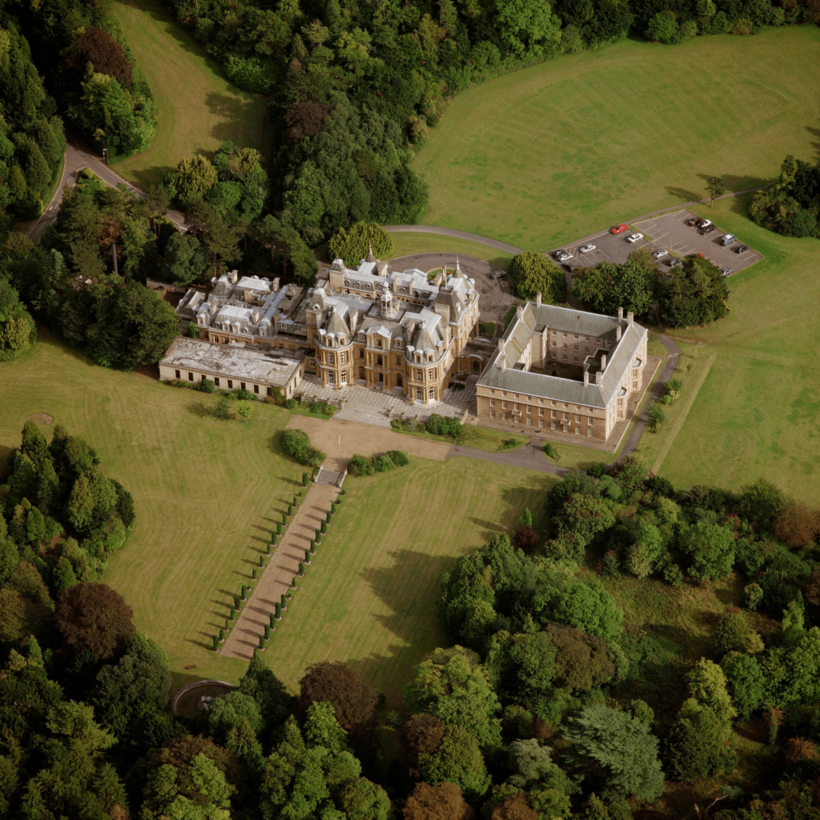A main entrance, a garden entrance, a luggage entrance, a business entrance, a nursery entrance and a second garden entrance for the private use of family and invalids. A principal staircase, a private family staircase, a servants’ staircase, a “bachelor’s stair”, a “young ladies’ stair” and “other Special Stairs” (purpose unspecified). Separate corridors for male and female servants, two more for the housekeeper and butler, one for the cook and another for the nurseries.
The period from the mid-1860s to 1914, which this book covers, was the era in which new country houses — about 270 of them — were being built from scratch by uninhibitedly wealthy people, British and American. While Ferdinand de Rothschild was creating Waddesdon Manor, employing his French architect Hippolyte Destailleur to pull together elements of different French châteaux, including Renaissance paneling in the billiard room of the bachelors’ wing, his cousin Alfred de Rothschild was trying to outdo him at Halton House 22 miles away, where he kept a private orchestra that he conducted with a diamond-encrusted baton.
At the same time as this new-build craze, Britain’s great old houses were starting to come on to the market for the first time after centuries in the possession of the same old families. The Settled Land Acts of the 1880s made it permissible for the “tenant for life” (ie landowner) to sell his land, but not his principal mansion or park. But a judgment in 1891 changed that. Thanks to one drunken, gambling wastrel, Willie, 4th Marquess of Ailesbury, going to court in desperation to flog his country house, Savernake Hall, and winning his case, it would from now on be possible for a tenant for life to drum up huge debts, then force through the sale of his ancestral seat. By 1900 dozens of country houses came on to the market each week.
On top of the aristocratic nervousness brought on by this new situation, inheritance tax was introduced in 1894, causing palpitations among landowners — who protested that they were employing hundreds of locals, and that if they had to sell one of their country houses to pay the horrible new tax, they would be less able to support them.
Alfred de Rothschild kept a private orchestra that he conducted with a diamond-encrusted baton.
The infiltration of the newly rich into British society was manifested in a new handbook called The Upper Ten Thousand: An Alphabetical List of All Members of Noble Families, which came out in 1875. It listed “all those who have a definite position” in Britain. Starting with Major General Sir Frederick Abbott and ending with the Bishop of Zululand, it included a scattering of “intruders” that grew with every subsequent edition: brewers, bankers and cotton manufacturers.
And goodness, people were snooty about the way these “parvenoos”, as they called them, did up their houses — as well as not a little anti-Semitic if the people were Jewish. Mary Gladstone, visiting Waddesdon, complained in a letter that “there is not a bookshelf in the house, save 20 improper French novels”. Visitors to Skibo Castle in the Highlands, bought and restored by the American Carnegie family, complained that the wallpaper patterns were “loud enough to be heard a good league into the Atlantic” while the check worn by the inhabitants was “loud enough to do duty for chessboards”. They thought it showy for the Carnegies to have a piper in full Highland dress piping at eight every morning, and kippers served to the sound of Wagner on the pipe organ in the hall.
These newcomers seemed to be enjoying themselves rather too much for British tastes. The Carnegies installed a private telephone exchange and a glass-roofed marble swimming pool. One of the most enjoyable aspects of this book is the palpable excitement felt by late 19th-century owners about their houses’ newfangled features. The Earl of Ellesmere at Worsely New Hall outside Manchester was thrilled by his half-timbered electricity-generating plant providing power to 1,100 electric lights.
The house also had an automatic passenger lift. “This lift is actuated by a series of push buttons clearly marked so that no lift attendant is necessary,” marveled Country Life (a magazine that, from its founding in 1897, celebrated Britain’s old country houses and promoted the new generation of architects it approved of, such as Lutyens). The Duke of Hamilton was proud of his “hydro-extractor” at Dungavel Lodge in Lanarkshire, which extracted water from clothes by centrifugal force. The laundry required an engineer on standby plus six maids for the weekly washing of 1,800 items.
They thought it showy for the Carnegies to have a piper in full Highland dress piping at eight every morning, and kippers served to the sound of Wagner on the pipe organ in the hall.
There were enough wealthy, history-obsessed eccentrics about to enable the realization of some striking new crazes. Landowners felt that medieval castles had been over-tampered with and must be re-medievalized. The young 3rd Marquess of Bute, a Catholic convert, employed the great medievalist architect William Burges to redesign his two Welsh castles, Cardiff and Castell Coch in the 1860-70s. Burges conjured up “Tennysonian dream worlds … plaster knights, painted pilgrims, gilded ceilings, castellated chimneypieces and grotesquely carved corbels”. The touch that summed up his lifestyle was the monkey bell push in the library. You had to push a nut in the monkey’s mouth to summon the servants. What larks! All these houses had their bachelor wings, with winter smoking room and summer smoking room.
What they didn’t have enough of was bathrooms. Vast houses with 22 bedrooms had just two. A 1909 article stipulated that the bath, basin and walls in those bathrooms must be all white, “so that by contrast our bodies may appear ruddy with health; and, looking well, we shall feel well”. It seemed more important that houses should have intercommunication telephones from bedroom to bedroom: vital for the successful country house party.
Tinniswood sometimes goes into long, padded digressions that I could have done without, such as a retelling of the royal baccarat scandal, and a six-page section on one earl’s son and his wife and their divorce. The book is quite long enough already. Please stick to your subject.
Everything changed when war broke out in 1914. Hugo Elcho, the Earl of Wemyss, ordered his manservants to join up. “I shall have no chauffeur, no stableman, no odd man to carry the coals,” complained his wife. Their two sons would be killed in the war.
In a garden party at Easton Lodge, their gothic revival country house in Essex, just two weeks earlier, the Earl and Countess of Warwick and their tenants had been happily celebrating prizewinning marrows and ducks. “The next day, Germany invaded Belgium,” Tinniswood writes in his crisp epilogue. “Soon, the band of the Essex Yeomanry would play Keep the Home Fires Burning as it marched into hell.”
Ysenda Maxtone Graham is a critic and the author of five books, including The Church Hesitant: A Portrait of the Church of England Today

